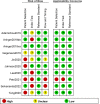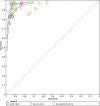Diagnostic accuracy of the European League against rheumatism/American College of Rheumatology-2019 versus the Systemic Lupus International Collaborating Clinics-2012 versus the ACR-1997 classification criteria in adult systemic lupus erythematosus: A systematic review and meta-analysis
- PMID: 36311745
- PMCID: PMC9599400
- DOI: 10.3389/fimmu.2022.1023451
Diagnostic accuracy of the European League against rheumatism/American College of Rheumatology-2019 versus the Systemic Lupus International Collaborating Clinics-2012 versus the ACR-1997 classification criteria in adult systemic lupus erythematosus: A systematic review and meta-analysis
Abstract
Aim: To evaluate the diagnostic performance of the American College of Rheumatology (ACR)-1997, the Systemic Lupus International Collaborating Clinics (SLICC)-2012, and the European League against Rheumatism (EULAR)/ACR-2019 classification criteria in adult patients with systemic lupus erythematosus (SLE).
Methods: PubMed, Embase, Web of Science and Cochrane Library databases were searched for literature comparing the three classification criteria of ACR-1997, SLICC-2012 and EULAR/ACR-2019, which took clinical diagnosis as reference. Meta-analysis was used to evaluate and compare the sensitivity, specificity and diagnostic odds ratio of ACR-1997, SLICC-2012 and EULAR/ACR-2019. To assess the early diagnosis capability of the classification criteria, subgroups of patients with disease duration < 3 years and < 1 year were selected for comparison of sensitivity and specificity based on the inclusion of the original study. The sensitivity and specificity of each item in three sets of classification criteria were evaluated. In addition, the clinical and immunological characteristics of patients who did not meet the three classification criteria were compared.
Results: Nine original studies were included in the analysis, including 6404 SLE patients and 3996 controls. Results showed that the diagnostic odds ratios (95% confidence interval) of the SLICC-2012 [136.35 (114.94, 161.75)] and EULAR/ACR-2019 [187.47 (158.00, 222.42)] were higher than those of the ACR-1997 [67.53 (58.75, 77.63)]. Compared with ACR-1997[(0.86 (0.82, 0.89)], SLICC-2012[(0.96 (0.93, 0.97)] and EULAR/ACR-2019[(0.95 (0.92, 0.97)] had higher sensitivity. The specificity of the three classification criteria was similar: ACR-1997, SLICC-2012, and EULAR/ACR-2019 were 0.93 (0.89, 0.95), 0.86 (0.79, 0.91), and 0.91 (0.85, 0.95), respectively. The sensitivity of SLICC-2012 and EULAR/ACR-2019 were higher than that of ACR-1997 in early-course subgroups. Patients who did not meet ACR-1997 had more hypocomplementemia, patients who did not meet SLICC-2012 had more cutaneous lupus and photosensitivity, and patients who did not meet EULAR/ACR-2019 had more cutaneous lupus and leucopenia.
Conclusions: SLICC-2012 and EULAR/ACR-2019 have better diagnostic ability than the ACR-1997, and the sensitivity of the former two criteria is also higher than that of the latter; Moreover, the SLICC-2012 and EULAR/ACR-2019 for patients in the early stages of disease performed equally excellent.
Keywords: ACR-1997; EULAR/ACR-2019; SLICC-2012; classification criteria; systemic lupus erythematosus.
Copyright © 2022 Lu, Tian, Ma, Zhong, Liu and Xue.
Conflict of interest statement
The authors declare that the research was conducted in the absence of any commercial or financial relationships that could be construed as a potential conflict of interest.
Figures




References
Publication types
MeSH terms
LinkOut - more resources
Full Text Sources
Medical

